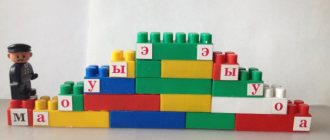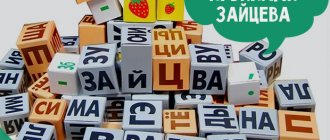“Read with expression!” - children often hear in school classes. But what does "expression" mean? After all, sometimes children read with memorized intonation, and the poem loses its liveliness.
Famous actress, TV presenter and speech coach Yana Poplavskaya spoke about the basic principles of oral speech and oratory as part of a master class organized by the “Heroes” project with the support of the Group.
Intonation is not just punctuation marks
It would seem that when reading you need to focus on punctuation marks: a comma is a small pause, a period is a long pause, an exclamation mark is a very long pause with increasing intonation. But we do not speak with periods and commas, but with intonation flows: we ourselves decide what exactly needs to be highlighted in the text, which word or part of the sentence to pay attention to. It is this word or part of the sentence that becomes the main thing; it may contain an emotion, a request, or displeasure. We try to draw the attention of listeners to this fragment of text. Sometimes we get bored when someone reads prose or poetry out loud. Why? We are not satisfied with the intonation flow. A story or poem comes to life with the help of a presentation in which there are no periods or commas, but only intonation.
Techniques for developing fluent, expressive, conscious reading article
Techniques for developing fluent, expressive, conscious reading
Teaching children to read correctly, fluently, consciously, and expressively is one of the tasks of primary education. And this task is extremely relevant, since reading plays a huge role in the education, upbringing and development of a person. Reading is a window through which children see and learn about the world and themselves. Reading is also something that is taught to younger schoolchildren, through which they are educated and developed. Reading abilities and skills are formed not only as the most important type of speech and mental activity, but also as a complex set of abilities and skills that have an educational character, used by students in studying all academic subjects, in all cases of extracurricular and extracurricular life.
Life shows that if a student has learned to read during the period of literacy training, then he occupies a prominent place in the class team and believes in his own strength, and, conversely, if a child has not mastered reading, he feels some kind of inferiority, loses faith in his own strength, in the ability to study successfully and in the class team is in the shadow. Morally, he will experience his shortcomings and will not be able to realize his abilities at school, the positive things that are inherent in him. According to psychologists, more than 200 factors influence academic performance, but it is impossible to take them all into account. They selected more than 40 factors that strongly influence academic performance. After testing and questioning students, it turned out that there is factor No. 1 – reading speed. Reading speed is the most important factor affecting academic performance. Therefore, systematic, purposeful work on developing and improving reading skills from class to class is necessary.
The reading process is not a process that can be formed quickly. Unfortunately, over the past 50 years, the time spent learning to read and write has decreased very sharply, almost halving. And if we take a primer from the 1950s and modern textbooks that a child should be reading in 2 months, then we will understand that the information richness, the pace that we give the child, has grown incredibly. But the child’s capabilities remained the same. Whatever specific functionality it had, that is how it remained. If in the 50s children of almost eight years old came to school, then in the last 20 years children of six years old came to school.
In the complex process of reading, three main points can be distinguished:
- Perception of these words. To be able to read means, first of all, to be able to guess from letters the words that they denote. Reading begins only from the moment when a person, looking at the letters, is able to pronounce, or remember, a specific word corresponding to the combination of these letters.
It is not difficult to show that in this process of perceiving letters as symbols of a certain word, not only vision, but also memory, imagination and the human mind take a large part. When we read words, we not only add letter by letter, but, having grabbed one or several letters, we immediately guess the whole word.
- Understanding the content associated with the words read. Each word we read can cause some changes in our consciousness that determine our understanding of this word. In one case, a certain, more or less vivid image appears in our consciousness, in another - some feeling, desire or abstract logical process, in the third - both of them together, in the fourth - no image or feeling, but only a simple a repetition of the perceived word, or perhaps another word associated with it.
- Reading assessment. The ability not only to read a book, but also to think critically about its contents is, as we know, not always observed.
The motive for reading is need. A primary school student mastering reading first has a need to learn to read, that is, to master the sound system and the process of reading itself—the emergence of words from letters. This piques his interest. Having mastered the initial reading (literacy), the student changes the motive for reading: he is interested in understanding what thought lies behind the words. As reading develops, the motives become more complex and the student reads with the goal of learning some specific fact or phenomenon; even more complex needs appear, for example, to know the motive of the hero’s action in order to evaluate it; find the main idea in a popular science text, etc.
Reading is directly related to oral speech. With the help of oral speech, the expressiveness of reading is practiced; When reading, means of verbal expressiveness are used, as well as coherent oral speech to convey the content of the text and communication between readers.
The perception of texts by younger schoolchildren does not correspond to the perception of a mature reader and has a number of features. It is characterized by:
- fragmentation, lack of integrity in the perception of the text;
- weakness of abstracting and generalizing perception;
- dependence on life experience;
- connection with the child’s practical activities;
- pronounced emotionality and spontaneity, sincerity of empathy;
- the prevalence of interest in the content of speech, rather than in the speech form;
- insufficiently complete and correct understanding of figurative and expressive means of speech;
- the predominance of the reproductive (reproducing) level of perception.
To form reading as an academic skill, it is necessary to keep this circumstance in mind. It is also important to take into account the characteristics of children’s cognitive activity. Children aged 6-7 years have not yet developed logical thinking; it is visual and effective in nature and requires reliance on practical actions with various objects and their substitutes - models. Then, gradually, thinking acquires a visual-figurative character, and, finally, logical abstract thinking arises. These stages of development of the cognitive activity of a primary school student leave an imprint on the nature of learning.
In the methodology, it is customary to characterize reading skill by naming its four qualities: accuracy, fluency, consciousness and expressiveness.
Accuracy is defined as reading smoothly without distortion affecting the meaning of what is being read.
Fluency is the reading speed that determines reading comprehension. This speed is measured by the number of printed characters read per unit of time (usually the number of words per minute).
Consciousness of reading in recent methodological literature is interpreted as an understanding of the author’s intention, awareness of the artistic means that help to realize this idea, and comprehension of one’s own attitude to what has been read.
Expressiveness is the ability, through oral speech, to convey to listeners the main idea of a work and one’s own attitude towards it.
In the first stages of learning to read and write, when sound-letter analysis is very important, pronunciation is very important for us. We have no right to teach a child to read silently. But from about 3rd grade, perhaps individually, perhaps at a very slow pace, the child should be taught to switch to reading silently. And this is a different reading mechanism. This is information supplied to the visual analyzer, it happens completely differently. We should understand this, but, unfortunately, we don’t, why? None of the methodologists can answer this.
Working on Reading Consciousness
Comprehension can be generally defined as reading comprehension. However, in the methodology this term is used in two meanings:
1) in relation to mastering the reading process itself (reading technique);
2) in relation to reading in a broader sense (T.G. Ramzaeva).
When they talk about consciousness in the first meaning, they mean how consciously the child performs the necessary operations that make up the voicing of printed signs: finds vowels, correlates them with merger syllables, sees consonants outside the mergers and realizes which merger syllable they belong to. lament.
The term conscious reading in the second meaning functions in the methodology at different levels of the reading process itself.
The first level, which often coincides with the analytical stage of developing reading skills, involves understanding most of the words used in a literal or figurative meaning; understanding individual sentences and their relationships with each other; understanding the meaning of individual parts of the text, their internal connection and interdependence and, finally, understanding the general meaning of the entire text.
The second level of conscious perception of the text is based on the first and involves understanding the subtext of the work, i.e. understanding its ideological orientation, figurative system, artistic means, as well as the position of the author and his own attitude to what he is reading.
We can also talk about the third level of conscious reading, when an individual is aware of his reading interests and has the skills that can satisfy them, in other words, he consciously determines his reading range, focusing on his capabilities. Thus, in modern methodology, the point of view has been established that reading consciousness presupposes:
- understanding the meaning of each linguistic unit of the text;
- understanding the ideological orientation of the work, its figurative system, visual and expressive means, i.e. the author’s position and his own attitude to what he read;
- awareness of oneself as a reader.
The ability to understand what is read develops in children gradually, in the process of all educational and cognitive work, simultaneously with the accumulation of knowledge, life experience and the development of logical thinking.
Reading awareness increases with the development of the child, with the expansion of his knowledge. But in the arsenal of methodological tools there are many, the use of which in the skillful hands of a teacher serves to develop reading consciousness. These include purposeful, well-thought-out preparation of children for a reading lesson, a conversation on what they read, causing children to become active, working on a plan for the work they read, various types of vocabulary work and creative retelling, etc.
So, for example, when conducting vocabulary work in a lesson, the following techniques can be used to find out the meaning of a word:
- Demonstration of an object or its image in a painting.
- Excursion to observe this object.
- The teacher's story about the subject, phenomenon.
- Complete logical definition of the concept.
- Description of the item.
- Subsuming a particular concept under a general one. (Antelope is an animal of the deer breed.)
- Division of a general concept into specific ones (Agricultural implements - seeders, harrows.)
- Appeal to the composition of the word.
- Appeal to context. Among the words unknown to children, there are those that, taken separately, are incomprehensible to children, but their meaning in context becomes clear.
If the word is the name of an important concept that will be worked on in class (for example, a scientific term), it is necessary to introduce it into the students' active dictionary. In this case, you can use, in addition to the mentioned techniques, another one - this is the display of small cards - posters. At the moment of explanation, the teacher hangs up a card with this word. The card can be attached to a picture with corresponding content.
To develop conscious reading, it is also useful to use deformed texts and unfinished stories in the classroom.
A system of training exercises for improving expressive reading skills.
Proper training in expressive reading is of great importance. Reading expressively yourself and teaching children to read expressively are not the same thing. The method of teaching expressive reading is based on the principle: to read means to penetrate into the meaning of a work, into the image of a word.
The means of speech expression are the following components of spoken speech:
- voice strength (loud - quiet);
- reading pace;
- reading timbre;
- pauses;
- logical stress;
- raising or lowering intonation.
These skills are developed using the following techniques:
- Breathing exercises.
- Diverse reading. (“Read the poem as a snake, a crow, a magpie would read it”).
- Exercises to develop the vocal apparatus. (We say it loudly, quietly, in a whisper).
- Practicing reading tempo. (We pronounce quickly, moderately, slowly).
- Diction exercises. (Tongue twisters, pure tongue twisters).
- Technique of imitation of the teacher.
Breathing exercises and voice training
"Blow out the candle." Take a deep breath and exhale all the air at once. Blow out one large candle. Now imagine that there are three candles on your hand. Take a deep breath and exhale in three breaths, blowing out each candle. Imagine that you have a birthday cake in front of you. There are many small candles on it. Take a deep breath and try to blow out as many small candles as possible, making the maximum number of short exhalations.
“Spray the laundry with water” (in one step, three, five). Take a deep breath and simulate splashing water on your laundry.
"At the flower shop." Imagine that you came to a flower shop and smelled the delightful aroma of flowering plants. Take a noisy breath in through your nose and exhale (2 – 3 times).
Exhale with a count. Take a deep breath and count loudly as you exhale until the air runs out.
Using tongue twisters (in unison):
Like on a hill on a hill
Cost 33 Egorki (deep breath)
One Egorka, two Egorkas......(until full exhalation).
It should be noted that after just a few classes there is enough air for more Yegoras.
To warm up the vocal cords, they offer so-called chanting exercises (in the 3rd quarter, during the lessons of studying the peculiarities of the construction of Russian folk tales, these exercises were replaced with a Russian folk choral song, for example: “There was a birch tree in the field”).
"Bear cubs." Imagine that you are little cubs and ask your mother bear to eat. Words must be pronounced drawlingly, in a bass voice, clearly pronouncing the sound [m].
Mom, I wish we could
Mom, could we have some milk?
"In the elevator". Imagine that we are riding in an elevator and announcing the floors. The higher the floor, the higher the voice, and vice versa. We go first from first to ninth, and then down.
"Handle in teeth." Write your name silently in the air. Say your name while holding the pen between your teeth and lips.
Speech apparatus training.
It is advisable to begin each literacy lesson with speech exercises (2-3 minutes). This type of exercise promotes the development of the speech apparatus, helps teach children to consciously observe the pronunciation of each sound, teaches the correct pronunciation of sounds, and promotes the development of clarity and correctness of speech.
Speech exercises may include the following exercises:
"Score a goal." The mouth is closed, the lips do not move, the tip of the tongue touches the cheeks.
“Brush your teeth.” Use the tip of your tongue to brush your teeth with your mouth closed.
"Horse". Clattering.
"Swing". Move the lower jaw from side to side, then forward and backward.
Make O and immediately into a wide smile And
Each lesson contains 1-2 exercises; the same exercise can be practiced throughout the week; this exercise can be repeated as needed (when becoming familiar with a sound that requires training of the speech apparatus).
Intonation warm-up.
Often, when demanding expressive reading from children, the teacher does not name what specific criteria this concept is determined by. There is no doubt that the concept of “expressive reading” is multifaceted, and the ability to read expressively largely depends on the life experience of children, the formation of emotional education, and the depth of feelings. And, of course, in elementary school, work on developing the ability to read expressively is just beginning. I think it’s right to start this work by developing three skills:
- Develop and give your voice intonations: joyful and sad, affectionate and angry, humorous and serious, mocking and approving, as well as intonations of enumeration, completion, confrontation.
- Choose the desired reading pace (fast, rhythmic or smooth, metered or a combination of these).
- Place logical stress in a sentence.
Practicing diction and reading pace.
In a literary reading lesson, it is useful to work on tongue twisters. This exercise helps develop the articulatory apparatus, improves diction and voice timbre. The method of working with tongue twisters is quite well known: from slow, distinct pronunciation to the most clear, fast pronunciation.
I only recommend highlighting with colored chalk in the recording of tongue twisters the letters indicating the sounds to be worked on, for example:
Senka and Sanka carried Sonya on a sled.
Sasha walked along the highway and sucked on a dryer.
I find it useful to start work with one line of tongue twister and add a new one at each lesson. To practice clear pronunciation, only one new line is offered, but the volume of reading material increases (2, 3, 4 lines). Since during 3-4 lessons reading a tongue twister begins with a text familiar to the children. And the guys, “taking a running start” (reading the familiar part of the tongue twister), prepared to read the new line at a good pace and without errors.
Examples of tongue twisters used in lessons:
Speak, speak, but don’t talk.
Geese are cackling on the mountain, and a fire is burning under the mountain.
There is grass in the yard, there is firewood on the grass, don’t cut wood on the grass in the yard.
Three little birds are flying through three empty huts.
Did they water the lily, did they see Lydia?
The fellow ate thirty-three pie pies and all with cottage cheese.
Forty mice walked, carrying forty pennies; two smaller mice carried two pennies each.
Senka is carrying Sanka and Sonya on a sled. Sledge - gallop, Senka off his feet, Sanka in the side, Sonya in the forehead, all in a snowdrift.
Prokop came - the dill was boiling, Prokop left - the dill was boiling, just as under Prokop the dill was boiling, so without Prokop the dill was boiling.
Tongs and pliers are our things.
Ways and techniques that contribute to the formation of correct reading fluency.
Correct reading is reading without distortion, i.e. without errors that affect the meaning of what is being read. Long-term observations of the development of reading skills in children allow us to identify several groups of typical mistakes made by students learning to read.
1. Distortion of sound-letter composition:
- omissions of letters, syllables, words and even lines;
- rearrangement of reading units (letters, syllables, words);
- insertion of arbitrary elements into reading units; – replacement of some reading units with others.
The reasons for such errors are imperfection of visual perception or underdevelopment of the articulatory apparatus. However, the so-called “reading by guess” can also cause distortions. This phenomenon is based on such a human property as anticipation - the ability to predict the meaning of a text that has not yet been read based on the meaning and style that is already known from the previous passage read. A guess appears in the reader with the acquisition of reading experience and is, thus, a sign of his progress in mastering the skill of reading. At the same time, the teacher must remember that the textual guess of an experienced reader rarely leads to errors that distort the meaning of what is being read, and the subjective guess of an inexperienced child often entails errors that prevent him from understanding what is being read.
2. The presence of repetitions.
Such errors involve repeating reading units: letters, syllables, words, sentences. The less perfect the reading skill, the smaller the reading unit is repeated. These errors are very close to the previous type, however, their causes are different. Repetitions, as a rule, are associated with the child’s desire to retain the component he has just read in his working memory. This is necessary for the little reader to comprehend what he read. Therefore, at the analytical stage of developing a skill, repetitions are inevitable and should be perceived by the teacher as a natural and even positive phenomenon. Excessive haste by the teacher and early suppression of “repetitions” in students’ reading can prevent the child from moving freely and naturally to the synthetic stage of reading.
3. Violation of the norms of literary pronunciation.
Among errors of this type, several groups can be distinguished:
1) errors are actually spelling errors; Among them, incorrect stress is the most common type. Such errors are associated with ignorance of pronunciation norms or ignorance of the lexical meaning of the words that are being read;
2) errors associated with the so-called “spelling reading”:
reading units are sounded in strict accordance with spelling, and not with pronunciation. The teacher must keep in mind that “spelling reading” is a mandatory period for developing a skill. The sooner a student learns to synthesize all the actions of the reading process (perception, pronunciation, comprehension), the sooner he will abandon “orthographic reading.” Therefore, work that helps the child comprehend what he reads will also help eliminate “orthographic reading”;
3) intonation errors, which are incorrect logical stresses, semantically inappropriate pauses. It is easy to see that such mistakes are made by the reader if he does not understand what he is reading. However, for a small child, the reading process requires not only intellectual, but also physical effort, so the cause of intonation errors in a small reader may be untrained breathing and speech apparatus.
A teacher can work correctly on correcting and preventing errors in reading only if he understands the reasons for erroneous reading and knows the methodology for working on errors. So, factors such as:
1) small field of view when reading;
2) underdevelopment (insufficient flexibility) of the articulatory apparatus;
H) shortness of breath;
4) ignorance of spelling norms;
5) ignorance of the lexical meaning of the word;
6) “guess” caused by the subjective type of reading.
In order for the development of reading accuracy to be effective, the teacher must determine a special reading mode:
1) daily exercises (special texts, tongue twisters, memorizing poetry and prose).
2) Read error prevention:
- preparation for reading,
- introductory conversation,
- work with split alphabet (grade 1),
- analysis of a difficult word by composition,
- choral reading aloud of difficult words (by syllables, parts, whole).
Also, the correctness of reading is influenced by: posture when reading, normal distance between the eyes and the text, preliminary reading “to oneself”, exemplary reading by the teacher.
The most important factor influencing the academic performance of schoolchildren is the reading pace: the higher it is, the better the progress.
Fluency is a reading speed that presupposes and ensures conscious perception of what is being read. Fluency standards are indicated in the reading program by year of study, but the main guideline for the teacher should be the individual's oral speech. An objective guide to fluency is the speech speed of a TV or radio announcer reading the news, which is approximately 120-130 words per minute.
Fluency depends on the so-called reading field and the duration of stops that the reader allows during the reading process. The reading field (or reading angle) is a segment of text that the reader’s gaze grasps in one go, followed by a stop (fixation). During this stop, awareness of what is captured by the gaze occurs, i.e. the perception is consolidated and comprehended. An experienced reader makes 3 to 5 stops on a line of unfamiliar text, and the sections of text that his gaze grasps at one time are uniform. The reading field of an inexperienced reader is very small, sometimes equal to one letter, so he makes many stops on the line and the segments of the perceived text are not the same. They depend on whether the words and phrases being read are familiar. Repetitions in the reading of an inexperienced reader are also associated with the comprehension of what has been grasped at one time: if he has not been able to retain the perceived segment in his memory, he has to return once again to the already spoken text in order to comprehend what he has read. Now it becomes clear that by training visual perception, the teacher works not only on accuracy, but also on reading fluency.
Reading fluency affects the quality of memorization of material: the faster a child reads, the easier it is to perceive what he read. To move on to such reading, it is necessary that the child begins to see the text in the form of words, and not individual letters. Constant work in class with numerous exercises leads to the fact that the child stops reading syllables and begins to perceive what he read figuratively. But before monitoring the level of development of reading skills, it is important to organize all previous work so that each student can cope with the proposed text. After all, with methodically correctly structured work, a student can not only achieve the required speed indicators, but also exceed them.
To achieve fluent reading skills, you need to solve the following tasks:
- development of working memory;
- development of peripheral vision (angle of vision);
- development of memory anticipation skills;
- formation of sustainable attention;
- prevention of repetitions when reading;
- replenishment of the student’s vocabulary;
- development of the articulatory apparatus.
Undoubtedly, students should spend 30–35 minutes on direct reading in class. We must not forget about this. Otherwise, what kind of reading fluency can we talk about?
Experiments conducted in recent years have shown that rapid reading activates thinking processes and is one of the means of improving the educational process for a wide variety of learning levels.
When children began to read with interest, reading fluency and comprehension appeared, and their performance in both the Russian language and mathematics increased noticeably.
In the course of a study on the development of fluent, conscious, expressive reading skills, the assumptions were confirmed that the development of reading skills will be effective if you select the text and understand what you read, i.e. create a “success situation”, conduct exercises for expressive reading in the system, starting with the simplest ones and gradually complicate them.
The use of various methods and techniques contributes to the formation of competent fluent reading, makes reading lessons interesting, lively and emotional. The variety of tasks attracts and holds the attention of children, develops an interest in reading, which then does not fade away in subsequent grades.
“Without reading there is no real education, there is no, and there can be no taste, no style, no multifaceted breadth of understanding,” wrote A. Herzen, and V.A. Sukhomlinsky said that “you cannot be happy without knowing how to read. Anyone who does not have access to the art of reading is an ill-mannered person, a moral ignoramus.”
Psychologists say that more than 200 factors influence a student’s performance. But if you carefully examine them, the number one factor in influencing a student’s performance is still the ability to read fluently!
Watch your breath
There is a special reading technique: read aloud a sentence that does not carry a semantic load, in one breath. You only need to exhale when the sentence you want to emphasize begins. This creates a pause that is not provided for in the written text. You can intonate without thinking, using only your breath. There is no need to emphasize every word, because in the text all words cannot be the main ones. It should be understood that important words may be different for each reader. That is why people sometimes read the same work with completely different intonations, which give a feeling of warmth, coldness, detachment, despair, everything that cannot be expressed in words.
Watch your speed
The beginning and end of any work, be it poetry or prose, must be read slowly. At the beginning of reading, the listener must tune in, understand that his attention now belongs to you. If you start jabbering right away, the attention of your listeners will quickly disappear, and the picture you are supposed to paint with your words will no longer be interesting. Another recommendation for children is not to neglect reading aloud for a while. As a practice, you can try reading 120 words per minute without stopping. Some children aged 9-10 years often read aloud as if syllable by syllable. But if you read text at speed for at least 15 minutes every day, you will soon be able to overcome the “120 words per minute” barrier.
How to determine size
Poet Boris Pasternak. Photo: Alexander Less / TASS
Peter Zabolotsky. Portrait of Mikhail Lermontov (fragment). 1837. State Tretyakov Gallery, Moscow
Poet Vladimir Mayakovsky. 1922 Photo: reproduction from TASS Photo Chronicle
Another manifestation of rhythm in verse is meter, that is, the repetition of a certain ratio of stressed and unstressed syllables. For example, if the first syllable is stressed, the second is unstressed, the third is stressed, the fourth is unstressed again, and so on, then the poem is written in trochee. For example, like the same “Winter Evening” by Pushkin: “The STORM covers the sky with darkness.”
And if, on the contrary, the pair “unstressed - stressed” is repeated several times in a line, this is an iambic. For example, Boris Pasternak’s poem “Loving others is a hard cross” and the legendary “Eugene Onegin” by Pushkin (“My Uncle of the Most Honest Rules”) were written in iambic.
Each pair of syllables in iambic and trochee is called a foot, and the number of such pairs determines the length of the poetic line - that is, the size. The size can be three-foot, four-foot, pentameter, and so on - depending on the number of feet. For example, Mikhail Lermontov’s poem “I go out alone on the road...” is written in trochee pentameter, and Pushkin’s “Message to the Censor” (“The sullen guardian of the muses, my long-time persecutor”) is written in iambic hexameter.
To learn how to define trisyllabic meters, anapest and dactyl, read the materials in the “Word of the Day” section.
The author is the one who reads aloud
The author of any oral text, even if it is written by a great writer, can be imagined as the one who pronounces it. Because it is the reader who decides how this text will sound. Before you read a text out loud, you, as the author telling the story, must decide for yourself what is important to you. The same applies to retelling what you read, when you need to remember the main ideas, and not learn everything by heart. When reading aloud, special attention should be paid to the characters in the text. They differ in character, but a specific character must be assigned to them by the one who pronounces the text. This can be done using intonation.
Place accents and highlight the main thing
When communicating with an interlocutor, be it in a small company or speaking in front of an audience, you need to learn to control yourself. It is important to hear your intonation flow and understand which part of the story will be the main one in order to adjust your intonation in time. The rest of the text is just a frame for this main part. An analogy could be a picture in a frame: what belongs to the frame needs to be read quickly and easily, in one go. But as soon as an event occurs in the text, you need to stop and describe the picture differently. Even if you are reading the text from a page, the reading should be an enjoyable story to listen to. After all, our speech is one of the most important tools for successful communication.
Practical tips on how to correctly read poetry with expression
The expressiveness of pronunciation depends largely on the correct use
- logical stresses
- pauses
- intonation.
Now let's look at how to master these verbal techniques to perfection.
1. Create a text score .
This is a kind of outline of the poem, where all logical stresses, pauses and important words will be highlighted. Indicate with dashes
- growth of intonation (descending or ascending);
- pause length (long, short, medium).
All values must be entered in pencil. Keeping this diagram in mind, you will be able to correctly reproduce intonation.
2. Control your breathing .
Try not to take in excess air into your lungs so that unexpected pauses do not occur.
3. Diction is extremely important!
If you want to learn how to read poetry correctly, then be sure to work on your diction. Only confident, clear and correct pronunciation of words will help you move and develop in this path.
It is important to fully delve into the poem, feel it and understand the meaning . There is no need to cram poetry, no need to rush. It is important to understand what you read and sincerely enjoy this moment.
Create a high-quality emotional background , gesture and use facial expressions. Hone your poetic artistry by practicing in front of a mirror.









